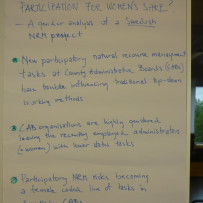Why are collaborative water governance approaches difficult to incorporate? A gender theory perspective

This blog is written by Stina Powell and Lotten Westberg. Both work at SLU in Uppsala, Sweden.
Despite the increasing recognition of the importance of collaborative and participatory approaches to achieve more sustainable governance of water resources, their realization has encountered problems and only enjoyed limited traction within environmental agencies responsible for their implementation. One explanation for this, found in literature, is that environmental agencies and organizations are hierarchical and sectorial and not suited to dealing with inclusive and holistic approaches.
In our project we apply gender theory to further examine the structural barriers associated with implementing collaborative approaches within pre-existing environmental directives and regulations. The reason for this is that we, by taking part in the evaluation of a Swedish pilot project explicitly aiming to create collaborative and participatory governance of coastal and marine areas, discovered that the collaborative approach seemed to have weak support among the responsible agencies, while a notable number of the appointed project leaders were women. This led us to address the question of how collaborative environmental governance approaches relate to the norms prevailing within the environmental organizations and agencies responsible for their implementation. We asked if the competencies connected to such approaches are, maybe not only gendered, but undervalued because they are gendered.
So far we have completed the first study were we, based on gender theories, conducted a deeper exploration of this question. By paying attention to existing norms of masculinity and femininity within the environmental agencies, we examine how the processes of enabling co-management of coastal and marine protected areas in Sweden are interpreted, enacted, and why. Our analysis led to the following conclusions:
Collaborative approaches to environmental management are seen as something with less status than scientific, top-down approaches and expert solutions in the environmental organizations we studied. There is a danger that co-management and similar approaches to environmental governance will become women’s tasks in the responsible agencies because of the way the skills needed to facilitate participatory processes are feminized. The way the agencies appear to marginalize collaborative projects further reproduces normative structures and the view that these types of projects should be seen as exceptions to more traditional management approaches. Based on the observation that it is mainly women leading these types of processes, there is a risk that the notion that these are women’s tasks, will become part of the normative structure. Research shows that organizations are structurally discriminating against women and what is considered feminine in a particular setting. Thus we argue that, due to the feminization of participatory environmental management, these approaches have less status and less influential power than do the traditional, masculine patterns in bureaucratic organizations.
The next step in our research is to go beyond Sweden by studying of other cases in the CADWAGO project. We will post the same questions as we did in the Swedish case. Gender perspectives on natural resource governance in countries in the “industrialized west” are an under-researched area.
